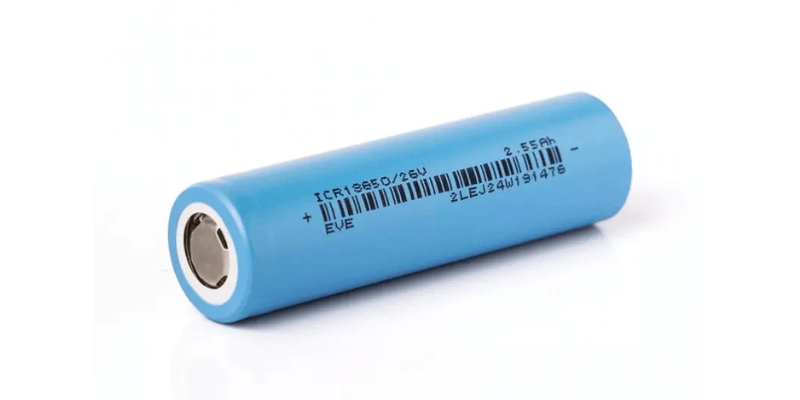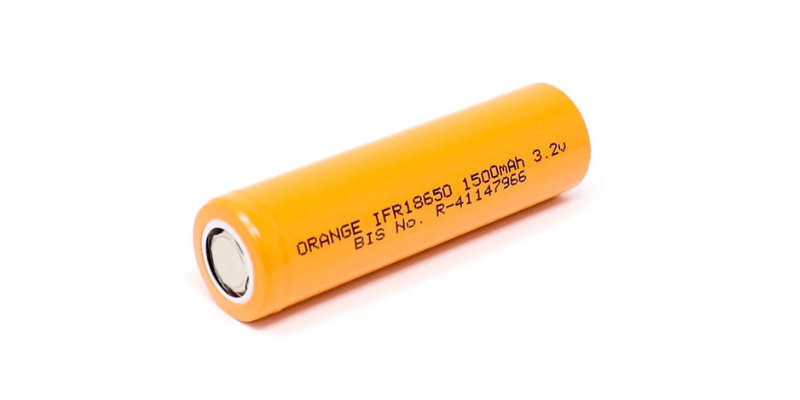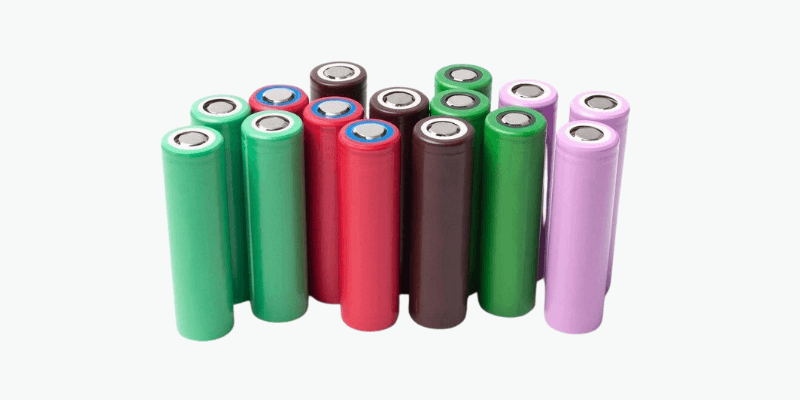Понимание различий между батареями IMR, ICR, INR и IFR 18650 необходимо для оптимального использования. Каждый тип имеет свой химический состав и профиль производительности. В этой статье представлен подробный анализ каждого типа батарей, подчеркиваются их уникальные свойства и области применения.
ИМР 18650 Аккумулятор
Химический состав
IMR означает оксид лития-марганца (LiMn2O4), катодный материал, используемый в литий-ионные аккумуляторы. “Р” указывает на высокое содержание марганца.
Преимущества
- Повышенная безопасность: Оксид лития-марганца стабилен, восстанавливая термический побег риски и повышение стабильности во время циклов зарядки и разрядки.
- Высокая скорость разряда: Аккумуляторы IMR имеют более низкое внутреннее сопротивление, что обеспечивает более высокую скорость разряда, что делает их идеальными для энергоемких устройств, таких как модов для электронных сигарет.
Недостатки
- Низкая емкость: Батареи IMR могут иметь низкий уровень заряда. плотность энергии чем некоторые другие варианты 18650, что может сократить срок службы батареи или ее емкость в приложениях с низким энергопотреблением.
Приложения
Аккумуляторы IMR 18650 широко используются в устройствах, требующих немедленной выдачи энергии:
- Электронные сигареты: Их способность к быстрому разряду делает их популярными в сообществе вейперов из-за быстрого всплеска испарения.
- Портативные системы освещения: Высокопроизводительные фонарики работают от батарей IMR.’ способность мгновенно доставлять большую мощность.
- Электроинструменты: Устройства, которым необходимы значительные приливы мощности, такие как дрели и пилы, находят элементы IMR подходящими для своих требований к высокому энергопотреблению.

ICR 18650 Аккумулятор
Химический состав
ICR означает оксид лития-кобальта (LiCoO2), катодный материал, используемый в литий-ионных батареях.
Преимущества
- Высокая емкость: Батареи ICR обладают замечательной плотностью энергии, что позволяет им хранить больше энергии, чем многие другие батареи 18650.
Недостатки
- Проблемы безопасности: Химия оксида лития-кобальта представляет угрозу безопасности, особенно в сценариях с высоким уровнем стока. Батареи ICR более подвержены перегреву и нестабильности, что делает обеспечение безопасности критически важным.
- Более низкая стабильность: Батареи ICR имеют более высокий риск взрыва или возгорания, чем другие типы 18650, из-за использования катода из оксида лития-кобальта, который менее стабилен.
- Более низкие скорости разряда: Эти батареи разряжаются медленнее, чем такие варианты, как IMR, что ограничивает их использование в приложениях с высоким потреблением энергии.
Приложения
Батареи ICR 18650 используются в устройствах, в которых высокая емкость важнее мгновенной выходной мощности.
- Бытовая электроника: Ноутбуки, цифровые камеры и портативная электроника выигрывают от батарей ICR.’ стабильная, длительная мощность.
- Устройства с низким стоком: Гаджеты, такие как медицинские устройства и фонарики малой мощности, используют батареи ICR для обеспечения постоянной энергии.

18650 индийских рупий Батарея
Химический состав
INR означает оксид лития, никеля, марганца, кобальта (Li-NiMnCoO2), катодный материал, используемый в литий-ионных батареях.
Преимущества
- Сбалансированная производительность: Аккумуляторы INR обеспечивают умеренную емкость и скорость разряда, обеспечивая достойную выходную мощность.
- Улучшенная стабильность: Эти батареи демонстрируют лучшую стабильность и меньший риск перегрева при интенсивном разряде по сравнению с такими вариантами, как элементы ICR.
Недостатки
- Умеренная плотность энергии: Батареи INR имеют меньшую плотность энергии, чем некоторые аналоги. Это означает, что они могут не подойти для энергоемких устройств, таких как смартфоны.
- Высокая стоимость: Батареи INR дороже, чем другие типы батарей 18650.
Приложения
Аккумуляторы емкостью 18650 индийских рупий идеально подходят для устройств, которым требуется баланс емкости и выходной мощности.
- Портативная электроника: Ноутбуки, блоки питания и некоторые инструменты выигрывают от стабильной работы в течение умеренных периодов времени.
- Устройства с умеренным стоком: Гаджеты, такие как фонари среднего класса и приборы средней мощности, используют батареи INR для сбалансированной емкости и мощности.

ИФР 18650 Аккумулятор
Химический состав
IFR означает оксид литий-железо-фосфата (LiFePO4), катодный материал, используемый в литий-ионных батареях.
Преимущества
- Повышенная безопасность: Аккумуляторы IFR имеют превосходный профиль безопасности, что значительно снижает риск температурного разгона и нестабильности.
- Долговечность: Они также имеют более длительный срок службы, чем другие варианты 18650, что делает их популярными в приложениях, где долговечность имеет приоритет.
Недостатки
- Более низкая плотность энергии: Батареи IFR имеют меньшую плотность энергии, чем аналоги, что влияет на их емкость и запас энергии.
- Умеренная скорость разряда: Они обеспечивают разумную скорость разряда по сравнению с батареями с высоким уровнем разряда, такими как IMR, что ограничивает их использование в приложениях, требующих быстрой подачи энергии.
Приложения
Аккумуляторы IFR 18650 широко используются там, где безопасность и долговечность имеют решающее значение.
- Системы хранения солнечной энергии: Их повышенная безопасность и срок службы обеспечивают надежность.
- Электромобили: В том числе автомобили и велосипеды, они также выигрывают от батарей IFR из-за их долговечности и увеличенного срока службы в условиях интенсивного использования.

Сравнительная таблица
Вот сравнительная таблица, суммирующая различия между батареями IMR, ICR, INR и IFR 18650:
| Скорость разряда | Плотность энергии | Безопасность | Цена | Приложения | |
| IMR18650 | Выше | Умеренный | Безопаснее | Умеренный | Устройства с высоким стоком |
| ICR18650 | Низкий | Высокий | Менее безопасно | Низкий | Ноутбуки, цифровые фотоаппараты |
| 18650 индийских рупий | Высокий | Умеренный | Безопасный | Высокий | Power Bank, Гаджеты |
| ИФР18650 | Умеренный | Низкий | Самый безопасный | Выше | Системы хранения солнечной энергии, электромобили |
С точки зрения безопасности батарея IFR18650 занимает первое место, а ICR18650 — самое низкое. По скорости разряда лидирует IMR18650. ICR18650 обеспечивает более высокую плотность энергии, а INR18650 уравновешивает оба аспекта.
Часто задаваемые вопросы
Каковы характеристики аккумулятора 18650?
Батарея 18650 имеет диаметр 18 мм и длину 65 мм. Он предлагает мощности от от 1200 мАч до 3600 мАч и работает при напряжении примерно от 3,6 до 3,7 вольт.
Каково напряжение батареи IMR?
Аккумуляторы IMR 18650 имеют номинальное напряжение 3,7 вольта и полностью заряженное напряжение около 4,2 вольта.
В чем разница между батареей INR и IMR?
Оба являются клетками с высоким дренажем. Химия IMR безопаснее, с более высокой производительностью и меньшей производительностью по сравнению с ICR. INR предлагает более высокий потенциал производительности и энергии, чем IMR.

